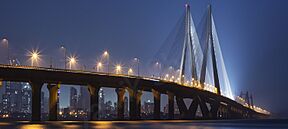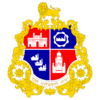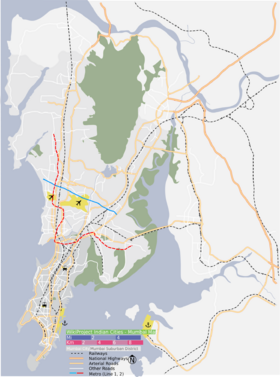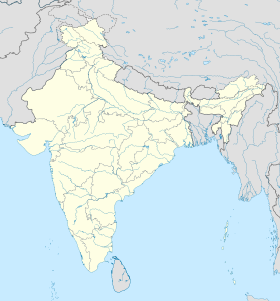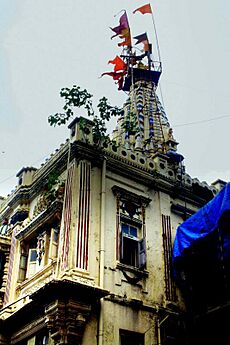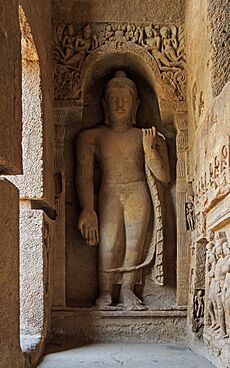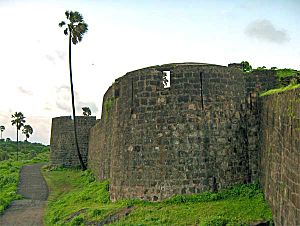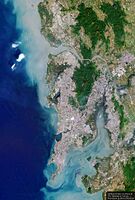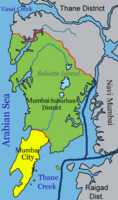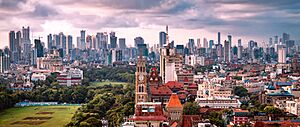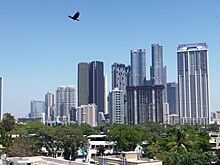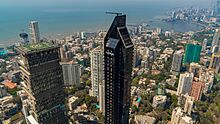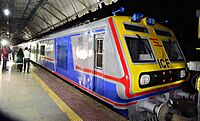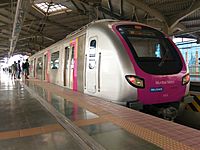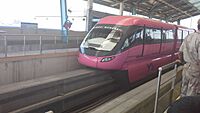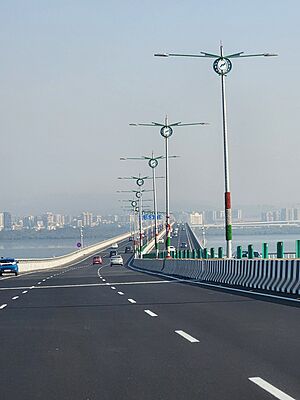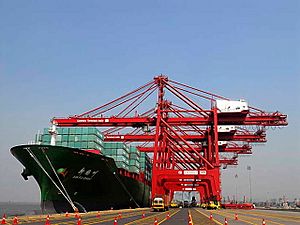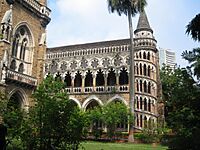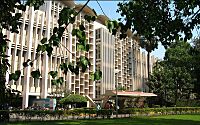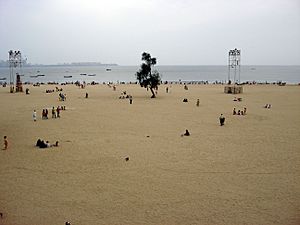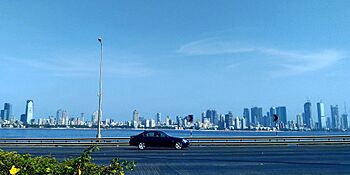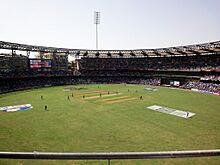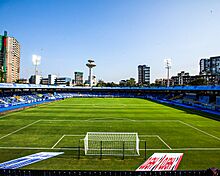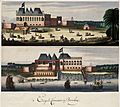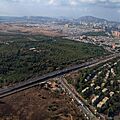Mumbai facts for kids
Quick facts for kids
Mumbai
Bombay
|
||
|---|---|---|
|
Skyline of Mumbai across Back Bay
Gateway of India
The World Towers
Marine Drive
Taj Mahal Palace Hotel
Chhatrapati Shivaji Maharaj Terminus
Bandra–Worli Sea Link
|
||
|
||
| Nickname(s):
City of Dreams, City of Seven Islands, Maximum City, The Big Coconut, The City That Never Sleeps
|
||
| Country | ||
| State | ||
| Division | Konkan | |
| District | Mumbai City Mumbai Suburban |
|
| First settled | 1507 | |
| Named for | Mumbadevi | |
| Government | ||
| • Type | Municipal Corporation | |
| • Body | Brihanmumbai Municipal Corporation | |
| Area | ||
| • Megacity | 603.4 km2 (233.0 sq mi) | |
| • Metro | 6,328 km2 (1,681.5 sq mi) | |
| Elevation | 14 m (46 ft) | |
| Population
(2011)
|
||
| • Megacity | 12,442,373 | |
| • Rank | 1st | |
| • Density | 20,620.4/km2 (53,407/sq mi) | |
| • Metro | 18,414,288 20,748,395 (Extended UA) |
|
| Demonym(s) | Mumbaikar, Bombayite, Mumbaiite | |
| GDP | ||
| • Megacity | ₹7.17 trillion (US$120 billion) | |
| • Metro | $277 billion | |
| • PPP | $400 billion | |
| Time zone | UTC+5:30 (IST) | |
| PINs |
400 001 to 400 107
|
|
| Area code(s) | +91-22 | |
| Vehicle registration |
|
|
| HDI | ||
| International airport | Chhatrapati Shivaji Maharaj International Airport | |
| Rapid Transit | Mumbai Metro and Mumbai Monorail | |
| Official language | Marathi | |
| Official name: Elephanta Caves, Chhatrapati Shivaji Terminus, and The Victorian and Art Deco Ensemble of Mumbai | ||
| Type: | Cultural | |
| Criteria: | i, ii, iii, iv | |
| Designated: | 1987, 2004, 2018 (11th, 28th 42nd sessions) | |
| Reference #: | [1]; [2] [3] | |
| Region: | Southern Asia | |
Mumbai (pronounced moom-bye), also known as Bombay, is a huge and exciting city in India. It is the capital of the state of Maharashtra. Imagine a city that's the financial heart of a country and also home to the famous Bollywood film industry! That's Mumbai.
With over 12.5 million people, Mumbai is the most populated city in India. It's also one of the world's biggest metropolitan areas, with more than 23 million people living in and around it. Mumbai sits on the Konkan coast, right by the Arabian Sea, and has a natural harbor that's great for ships. It's often called the "City of Dreams" because so many people come here to find opportunities.
The city started as seven islands, which were once home to local fishing communities. Over centuries, different rulers controlled these islands. In 1661, the islands became part of the English Empire as a wedding gift! Later, a big project called the Hornby Vellard connected these islands, turning Mumbai into a major seaport. In 1960, Mumbai became the capital of the new state of Maharashtra.
Mumbai is a global city, known for its business, trade, and entertainment. It has important financial institutions like the Bombay Stock Exchange and is a hub for many big companies. It's also a center for science and nuclear research. People from all over India move to Mumbai for its many job opportunities.
Contents
What's in a Name?
The name Mumbai comes from Mumbā or Mahā-Ambā, who is a Hindu goddess. The local Koli people call her Mumbadevi. The word ā'ī means "mother" in the Marathi language, which is the Koli people's native language. So, Mumbai means "Mother Mumba."
The city was also known by older names like Kakamuchee and Galajunkja. When the Portuguese arrived, they called it "Bombaim." Some people thought this meant "good little bay," but experts say that's not quite right. The English later changed "Bombaim" to Bombay.
In November 1995, the Indian government officially changed the English name back to Mumbai. This was done to honor the local Marathi culture and move away from names given during British rule. Even today, some people still call it Bombay, but Mumbai is the official and widely used name.
People from Mumbai
People who live in Mumbai are called Mumbaikar (pronounced moom-bye-ker). The word -kar means "a resident of" in Marathi. You might also hear older terms like Bombayite.
Mumbai's Past
Early Days
Mumbai was built on what used to be seven separate islands: Isle of Bombay, Parel, Mazagaon, Mahim, Colaba, Worli, and Old Woman's Island. We don't know exactly when people first lived here, but ancient sediments show that people were here during the Stone Age. Later, the Koli fishing community settled on these islands.
Around 300 BCE, the islands became part of the Maurya Empire, ruled by Emperor Ashoka. The Kanheri Caves in Borivali were carved out of rock in the first century CE and became an important Buddhist center.
Over many centuries, different local rulers controlled the islands. Some of the oldest buildings and structures in the city, like the Jogeshwari Caves and Elephanta Caves, were built during this time.
In the late 1200s, King Bhimdev started his kingdom here. Later, the Delhi Sultanate and then the Gujarat Sultanate ruled the islands. During this time, many mosques were built, including the famous Haji Ali Dargah in Worli, built in 1431.
Portuguese and British Rule
In 1534, the Portuguese Empire took control of the seven islands of Bombay. They built churches and forts, like the Bombay Castle. The English wanted Mumbai because of its great natural harbor. In 1661, the islands were given to the English Empire as part of a wedding agreement when Catherine of Braganza married Charles II of England.
In 1668, England leased these islands to the English East India Company for a small yearly payment. The population grew very quickly. In 1687, the East India Company moved its main office from Surat to Mumbai, making it a very important center for trade.

By the mid-1700s, Mumbai became a major trading town, attracting many people from all over India. A huge project called the Hornby Vellard began in 1782 to connect the seven islands into one large landmass. This project was finished by 1845.
On April 16, 1853, India's first passenger railway line opened, connecting Mumbai to Thane. During the American Civil War (1861–1865), Mumbai became the world's main cotton trading market, which made the city's economy boom. The opening of the Suez Canal in 1869 made Mumbai one of the biggest seaports on the Arabian Sea.
Independent India
After India became independent in 1947, Mumbai became the capital of Bombay State. In 1950, the city's boundaries grew to form the Greater Mumbai Municipal Corporation.
There was a big movement called the Samyukta Maharashtra movement in the 1950s to create a separate state for Marathi-speaking people, with Mumbai as its capital. After protests, the state of Maharashtra was created on May 1, 1960, with Mumbai as its capital. A memorial called Hutatma Chowk (Martyr's Square) was built to honor those who died in the movement.
In the following decades, Mumbai and its suburbs expanded greatly. New areas like Nariman Point and Cuffe Parade were developed. A new city, Navi Mumbai, was also founded to help manage Mumbai's growing population.
Mumbai has faced challenges, including periods of unrest and difficult events. However, the city has always shown great strength and recovered. Today, Mumbai is India's commercial capital and a global financial hub. It has grown from a small fishing community to South Asia's largest city and home to the world's biggest film industry.
Mumbai's Location and Landscape
Mumbai is located on a narrow piece of land called a peninsula. It's on the southwest side of Salsette Island, with the Arabian Sea to the west and creeks to the east and north.
The city is divided into two main parts: Mumbai City district and Mumbai Suburban district. The city district is often called the Island City or South Mumbai. The total area of Mumbai is about 603 square kilometers.
Mumbai is at the mouth of the Ulhas River on India's western coast. Many parts of the city are just above sea level. Northern Mumbai is hilly, and the highest point is 450 meters high. The Sanjay Gandhi National Park is a large green area partly within the city.
The city gets its water from six main lakes, including Tulsi Lake and Vihar Lake, which are inside the national park. Three small rivers also start in the park. The coastline has many small inlets and bays. The eastern coast has large mangrove swamps, which are important for nature, while the western coast has sandy and rocky beaches.
Mumbai is in an area where earthquakes can happen because there are 23 fault lines nearby. It's classified as a Seismic Zone III region, meaning a moderate earthquake could occur.
Mumbai's Weather
Mumbai has a tropical wet and dry climate. This means it has a very rainy season and a long dry season. The cooler season is from December to February, followed by a hotter season from March to May.
The main rainy season, called the southwest monsoon, happens between June and September. Mumbai gets a lot of rain during these months. The average yearly rainfall is about 2213 millimeters. The highest rainfall ever recorded in one day was 944 millimeters on July 26, 2005.
The average yearly temperature is about 27 degrees Celsius. The highest temperature ever recorded was 42.2 degrees Celsius in April 1952, and the lowest was 7.4 degrees Celsius in January 1962.
Tropical cyclones are rare in Mumbai. However, the city can experience monsoon floods, especially during heavy rains and high tides. This is partly because of its low-lying areas and how the city has grown. The government is working on plans to improve drainage and reduce flooding.
Mumbai's Economy
Mumbai is often called the "New York of India" because it's India's biggest financial and business center. It creates a large part of India's total economic output.
Since India opened up its economy in 1991, Mumbai has seen a huge economic boom. It's one of the most productive metropolitan areas in India. Many of India's largest companies, like Tata Group and Reliance Industries, have their main offices in Mumbai. The city is also home to important financial institutions such as the Reserve Bank of India and the Bombay Stock Exchange.
In the past, Mumbai's economy relied a lot on textile factories and its seaport. But now, it has many different industries, including finance, engineering, diamond polishing, healthcare, and information technology. Major business areas like Nariman Point and Bandra Kurla Complex are key financial centers.
Mumbai is also a growing hub for the information technology industry. The Santacruz Electronic Export Processing Zone (SEEPZ) offers great facilities for IT companies.
Many people in Mumbai work for the government. There are also many self-employed people who work as street vendors, taxi drivers, and mechanics. The port and shipping industry is very important, with Mumbai Port being one of India's oldest and most significant ports.
Mumbai has one of the highest numbers of billionaires in the world. It is the richest city in India. However, it's important to know that Mumbai also faces challenges with income inequality. Many residents struggle to find affordable housing, leading to large informal settlements like Dharavi, which is one of the most densely populated areas on Earth.
Getting Around Mumbai
Mumbai has many ways to get around, including local trains, monorails, metros, buses, taxis, auto rickshaws, and ferries. The local train and bus services are used by most people every day.
Trains and Metro
The Mumbai Suburban Railway, often called "Locals," is the main way people travel in the city. It carries millions of passengers daily. Trains can get very crowded during busy hours.
The Mumbai Monorail and Mumbai Metro systems have been built to help reduce overcrowding. The Monorail opened in 2014, and the first Metro line also opened in 2014.
Mumbai is also a major railway hub for long-distance trains connecting to other parts of India.
Buses
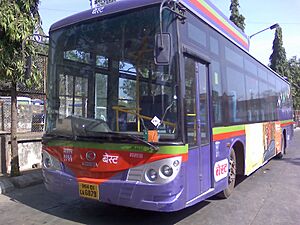
Mumbai's public buses, run by BEST, cover almost all parts of the city. They also go to nearby areas like Navi Mumbai and Thane. BEST has a large fleet of buses, including double-deckers and air-conditioned buses. Buses are good for shorter trips, while trains are more affordable for longer distances.
Roads
Mumbai is connected by several national highways. The Mumbai-Pune Expressway was India's first expressway. The Bandra-Worli Sea Link is a famous bridge that connects the island city to the western suburbs. The Mumbai Trans Harbour Link, opened in 2024, is India's longest sea bridge, connecting Mumbai with Navi Mumbai.
The city has many private vehicles, taxis, and auto rickshaws. Taxis and auto rickshaws use compressed natural gas (CNG), which is better for the environment.
Air Travel
The Chhatrapati Shivaji Maharaj International Airport is Mumbai's main airport and one of the busiest in India. It handles millions of passengers each year. A new airport, the Navi Mumbai International airport, is being built to help with the growing air traffic.
Sea Travel
Mumbai has two major ports: Mumbai Port Trust and Jawaharlal Nehru Port Trust. Mumbai Port has one of the best natural harbors in the world. Jawaharlal Nehru Port is India's busiest and most modern port, handling most of the country's container cargo. Ferries also provide access to nearby islands.
Mumbai is also an important base for the Indian Navy.
City Services
The city gets its drinking water from six lakes. The water is filtered at Bhandup, which is Asia's largest water filtration plant. Mumbai also has India's first underground water tunnel for water supply.
Electricity is provided by different companies in the city and suburbs. The power cables are mostly underground, which helps prevent theft and losses.
Cooking gas is supplied through cylinders or piped natural gas. For phones and internet, there are many service providers, offering both fixed line and mobile services. Mumbai has a very high number of internet users in India.
People of Mumbai
According to the 2011 census, Mumbai city had over 12.4 million people. The population density is very high, meaning many people live in a small area. The literacy rate is also very high, at 94.7%.
Mumbai is a diverse city with many different ethnic groups and religions. The main religious groups are Hindus (65.99%), Muslims (20.65%), Buddhists (4.85%), and Jains (4.10%).
The city is home to people from all over India. The largest groups are Maharashtrians (32%) and Gujaratis (20%). Mumbai also has unique communities like the Bombay East Indians (local Christians), Bene Israeli Jews, and the largest population of Parsi Zoroastrians in the world.
Languages Spoken
Marathi is the official language of Maharashtra and is widely spoken in Mumbai. English is also used a lot, especially in business and offices.
Mumbai has a large population that speaks many different languages. Besides Marathi, Hindi is the second most common language. You'll also hear Urdu, Gujarati, Tamil, Telugu, and Konkani.
A special type of Hindi, called Bambaiya, is spoken on the streets. It's a mix of Hindi, Marathi, Gujarati, Konkani, Urdu, and English words.
Learning in Mumbai
Schools
Schools in Mumbai are either run by the city government or are private schools. They follow different education boards, like the Maharashtra State Board, CBSE, or international boards. Marathi or English are the main languages used for teaching.
The city government runs many primary schools, teaching hundreds of thousands of students in eight different languages. They also have secondary schools.
Higher Education
After ten years of schooling, students go to junior college for two years, choosing arts, commerce, or science. Then they can go to university for a general degree or a professional degree like law, engineering, or medicine. Most colleges in Mumbai are part of the University of Mumbai, which is one of the largest universities in the world.
The Indian Institute of Technology Bombay (IIT Bombay) and Veermata Jijabai Technological Institute (VJTI) are top engineering and technology schools in India located in Mumbai. There are also leading medical institutes like Grant Medical College. Mumbai is home to many business schools and law colleges, including the oldest law and commerce colleges in India.
Mumbai also has important research centers like the Tata Institute of Fundamental Research (TIFR) and the Bhabha Atomic Research Centre (BARC).
-
Rajabai Clock Tower at the University of Mumbai is part of The Victorian and Art Deco Ensemble, a UNESCO World Heritage Site.
Mumbai's Culture and Fun
Mumbai's culture is a mix of old traditions and modern city life. It's known for its festivals, food, entertainment, and nightlife. The city is very diverse, with many different cultures, religions, and foods living together.
Mumbai is where Indian cinema began. Bollywood, the Hindi film industry, makes hundreds of movies every year. Many movies are filmed at Film City in Goregaon. Mumbai also has a growing Marathi film industry. The city hosts the Mumbai International Film Festival and the Filmfare Awards.

The city has many art galleries, like the Jehangir Art Gallery. The Asiatic Society of Mumbai is one of the oldest public libraries. The Chhatrapati Shivaji Maharaj Vastu Sangrahalaya (formerly The Prince of Wales Museum) has ancient Indian history exhibits.
Mumbai has a zoo called Jijamata Udyaan. The city's literary traditions are strong, with famous authors like Salman Rushdie.
People in Mumbai celebrate both Western and Indian festivals. Ganesh Chaturthi is the biggest and most important festival, with thousands of decorated altars set up around the city. Other popular festivals include Diwali, Holi, Christmas, and Eid. The Kala Ghoda Arts Festival showcases music, dance, theater, and films.
Beaches are a big attraction in Mumbai. Some popular ones are Girgaum Chowpatty and Juhu Beach. Essel World is a theme park near Gorai Beach, with Asia's largest water park, Water Kingdom.
City Buildings and Design
Mumbai's skyline has many tall buildings, especially built in the last 20 years. The city has a lot of residential skyscrapers because land is limited and the population is growing fast.
Architecture Styles
The buildings in Mumbai show a mix of styles, including Gothic Revival, Indo-Saracenic, and Art Deco. Many buildings from the British period, like the Victoria Terminus and University of Mumbai, were built in the Gothic Revival style. These buildings often combine European and Indian design elements.
You can find many Art Deco buildings along Marine Drive. Mumbai has the second-highest number of Art Deco buildings in the world, after Miami. In the newer parts of the city, modern buildings are more common. Mumbai has the most skyscrapers in India.
The Mumbai Heritage Conservation Committee helps protect the city's historic buildings. Mumbai has three UNESCO World Heritage Sites: the Chhatrapati Shivaji Terminus, the Elephanta Caves, and the Victorian and Art Deco Ensemble.
Media and Entertainment
Bollywood, the Hindi film industry, is based in Mumbai and produces many movies each year. The name Bollywood comes from "Bombay" and "Hollywood." Many films are shot at Film City studios. Mumbai is also a hub for the Marathi film industry and TV shows. Films in other Indian languages are sometimes made here too.
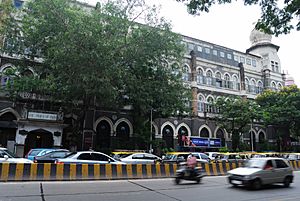
Mumbai has many newspapers, TV channels, and radio stations. Marathi newspapers are very popular. English newspapers like The Times of India are also widely read. Bombay Samachar, published in Gujarati since 1822, is Asia's oldest newspaper.
You can watch many Indian and international TV channels in Mumbai. The city is also home to many international media companies. There are several radio stations, both on FM and AM bands.
Sports in Mumbai
Cricket is the most popular sport in Mumbai. The city is home to the Board of Control for Cricket in India (BCCI) and the Indian Premier League (IPL). Mumbai's cricket team has won the Ranji Trophy many times. The city has two international cricket stadiums: the Wankhede Stadium and the Brabourne Stadium. The final of the 2011 ICC Cricket World Cup was played at the Wankhede Stadium.
Football is also popular, with many people following the FIFA World Cup and the English Premier League. The Mumbai City FC team plays in the Indian Super League.
In field hockey, Mumbai has teams like the Mumbai Marines. Matches are played at the Mahindra Hockey Stadium.
Mumbai also hosts events for Badminton, Kabaddi, and Rugby. The Mumbai Marathon is an annual running event. The city has also hosted international tennis tournaments.
Mumbai will host the 140th IOC Session in 2023, which is a big meeting for the Olympic movement.
Images for kids
See also
 In Spanish: Bombay para niños
In Spanish: Bombay para niños








